Review by Pete Vack
Lead photo: Tony Adamowicz gets the NART Ferrari 512 through Tertre Rouge at Le Mans in 1971. He and Sam Posey brought the increasingly troublesome Ferrari home to a third place overall. (Schlegelmilch photo)
If the 1950s at Le Mans were exemplified by the Cunningham efforts, and the 60s by the Ford domination, the 70s, at least from an American perspective, had to belong to one Sam Posey, who plugged on every year until 1978, placing in the top ten five times driving Ferraris, BMWs and Mirage-Renaults. He recalled his most thrilling ride during the 1970 event when he drove a Ferrari 512 for Chinetti:
“The first laps of that 1970 race were incredible. There were 11 Porsche 917s…and 13 Ferrari 512s. And we were all going down Mulsanne jockeying for position…and there was just something different about the steering after 220 mph. It was almost as if you were steering with the wheels as rudder. And there was a storm coming, and you could see those clouds, dense gray clouds at the end of the Mulsanne. The drama was just beyond belief. To me that was the apex of the era of Porsche vs Ferrari.”
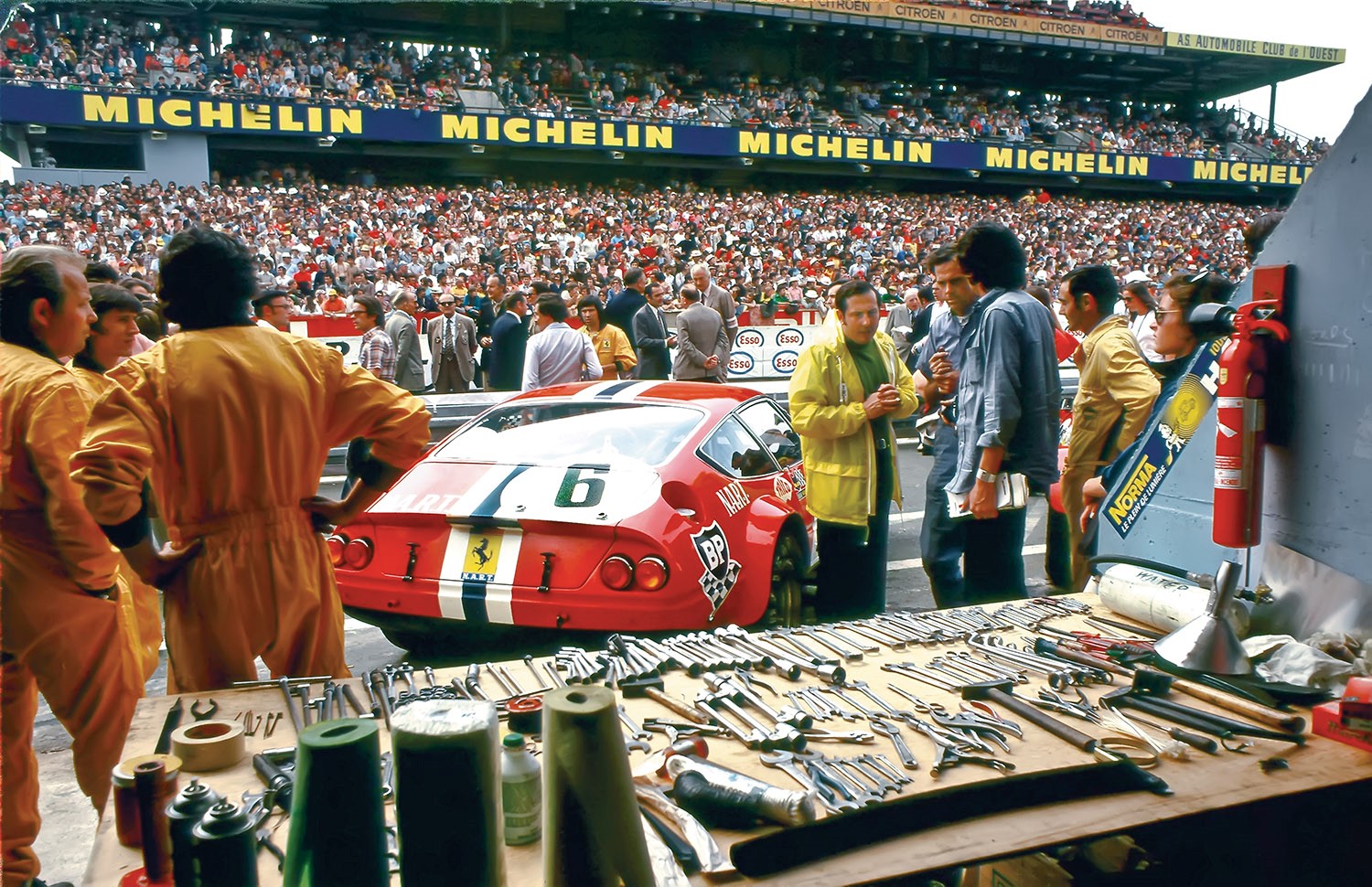
1973: The NART pit, with Team Manager Dick Fritz in yellow slicker. Luigi Chinetti Sr. can be seen in glasses standing across the track. (Bob Kennedy photo)
The NART team too had some good years at Le Mans in the 70s, and the old man’s son, Luigi Jr., did him proud by placing fifth in 1971, a DNF in 1972, and 13th in 1973, all in a NART 365GTB/4 Ferrari. Chinetti Jr. always had a good time at Le Mans, and the night before the start of the 1972 race, borrowed the Posey/Adamowicz NART Ferrari 365 GTB/4 to make a quick run to the coast to visit a girlfriend. He made it back in time, and Posey/Adamowicz finished 6th overall. Chinetti, driving with Masten Gregory, retired.
In 1979, the American Whittington brothers drove a Porsche 935 K3 to a well-deserved victory in the wettest Le Mans ever. “I’d never driven in rain like that,” remembered Bill Whittington. “The only way you knew there was a car in front of you was that it suddenly rained harder.”
Celebrity Seventies
The seventies were also noteworthy for the American celebrities who tackled the 24 hour endurance race. Considine opens with the McQueen filming of the 1970 event to be used in the movie Le Mans. This invasion of Le Mans by Hollywood was followed by a sincere effort by comedian Dickie Smothers, who drove a Corvette with John Greenwood in 1972. Smothers had been spotted by the team while he was driving in the F5000 series in the U.S., and was no doubt as fast as he was funny. The decade ends with a superb drive to second place by actor Paul Newman, who was constantly hounded by the press.
One might figure Considine, being in the business, would have special access to guys like McQueen and Newman. Well, yes and no. I asked Tim to tell us his experiences with the celebrities:
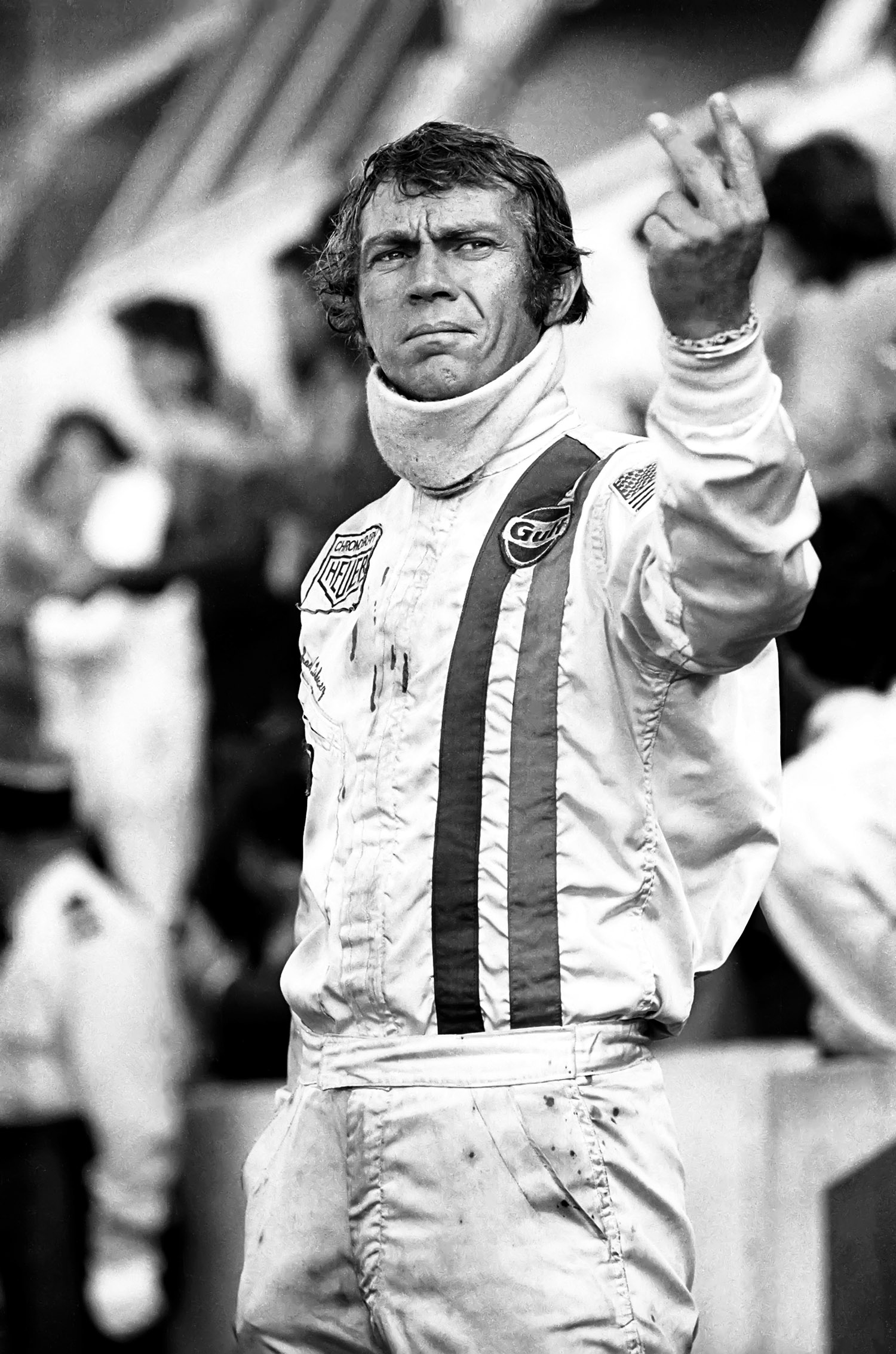
Classic McQueen shot. McQueen didn’t drive in the race but his movie made Le Mans more famous in America than any of the victories obtained by American drivers. (Autosportsltd.com photo)
Q. McQueen died in 1980, before you began research into this book. But did you ever speak to him about his experiences at Le Mans in general conversation?
A. Actually, no. I rarely saw Steve – until after he made the film. In the interim, I’d kind of pushed myself away from the movie industry. I got into photography and became fascinated by China (another passion) after reading Edgar Snow’s Red Star Over China and started writing a little. Our paths went different ways. Then I saw Steve in a restaurant, which was when he reminded me that my OSCA was the first racecar he ever drove. Eventually, it was the writing that got me back into racing. I’d done several columns for William Safire in the New York Times and it was Indy 500 historian Donald Davidson, still a friend, who knew my history and encouraged me to “write about something you know.” He introduced me to Autoweek, for whom I started writing stories. But when I saw Steve, the books were far away. Pity, as it might have been interesting.
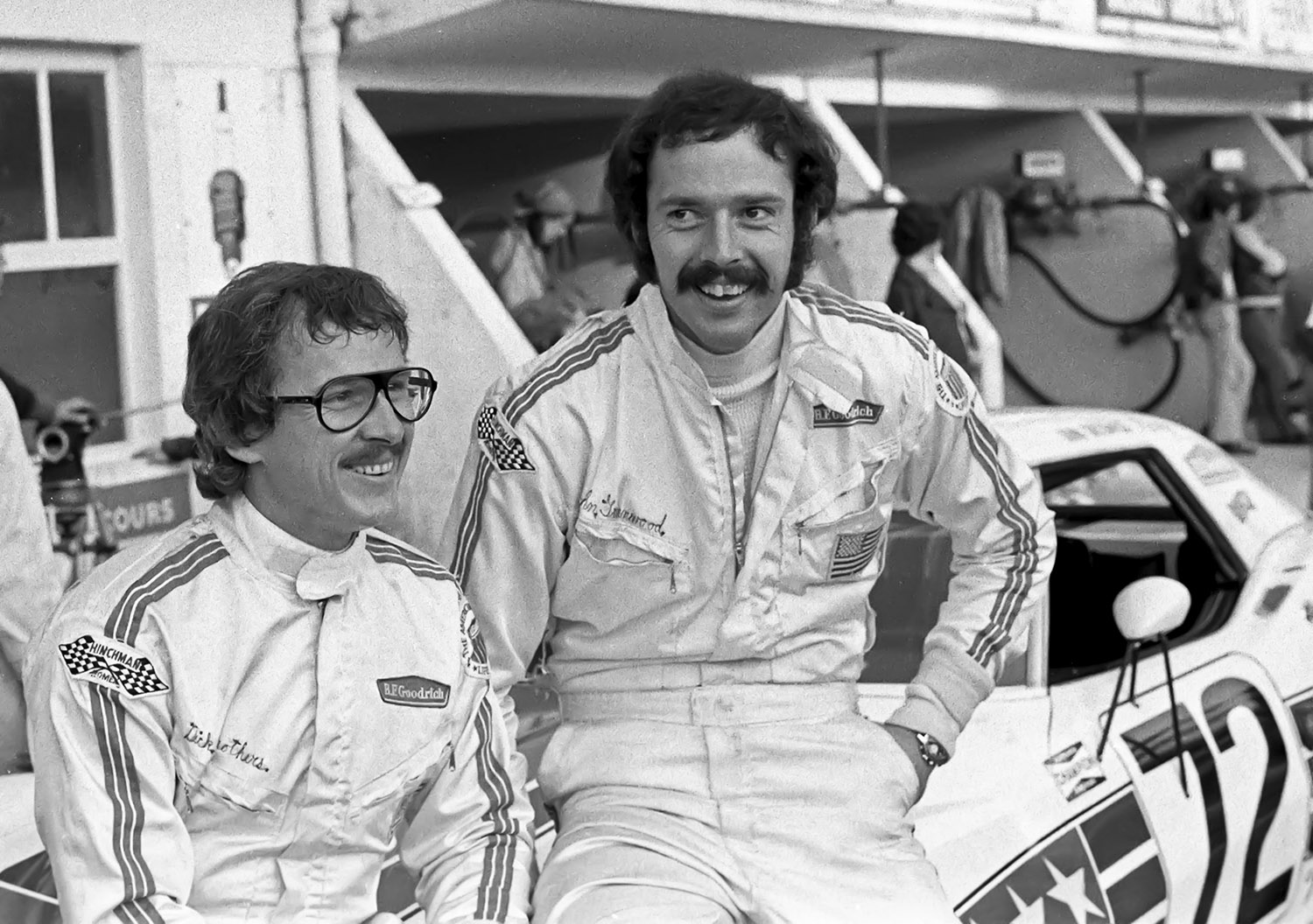
Dick Smothers, left was an excellent driver weaned on the dangerous F5000 series in the U.S. Here with John Greenwood at Le Mans in 1972. (Cahier Collection photo)
Q. Dick Smothers is an interesting character. Did you know him before you began your book? Can you tell us anything more about him?
A. Smothers is a good guy that I met when we both judged at Amelia Island. Quiet, self-effacing, but funny, always. He told good stories that strayed too far to be in the book. Maybe some of them will be put in the ‘MORE’ area that is currently under construction on the yanksatlemans website, a section that is only for those who have purchased the book. John Greenwood told me Dick was his favorite co-driver. He was a racer.
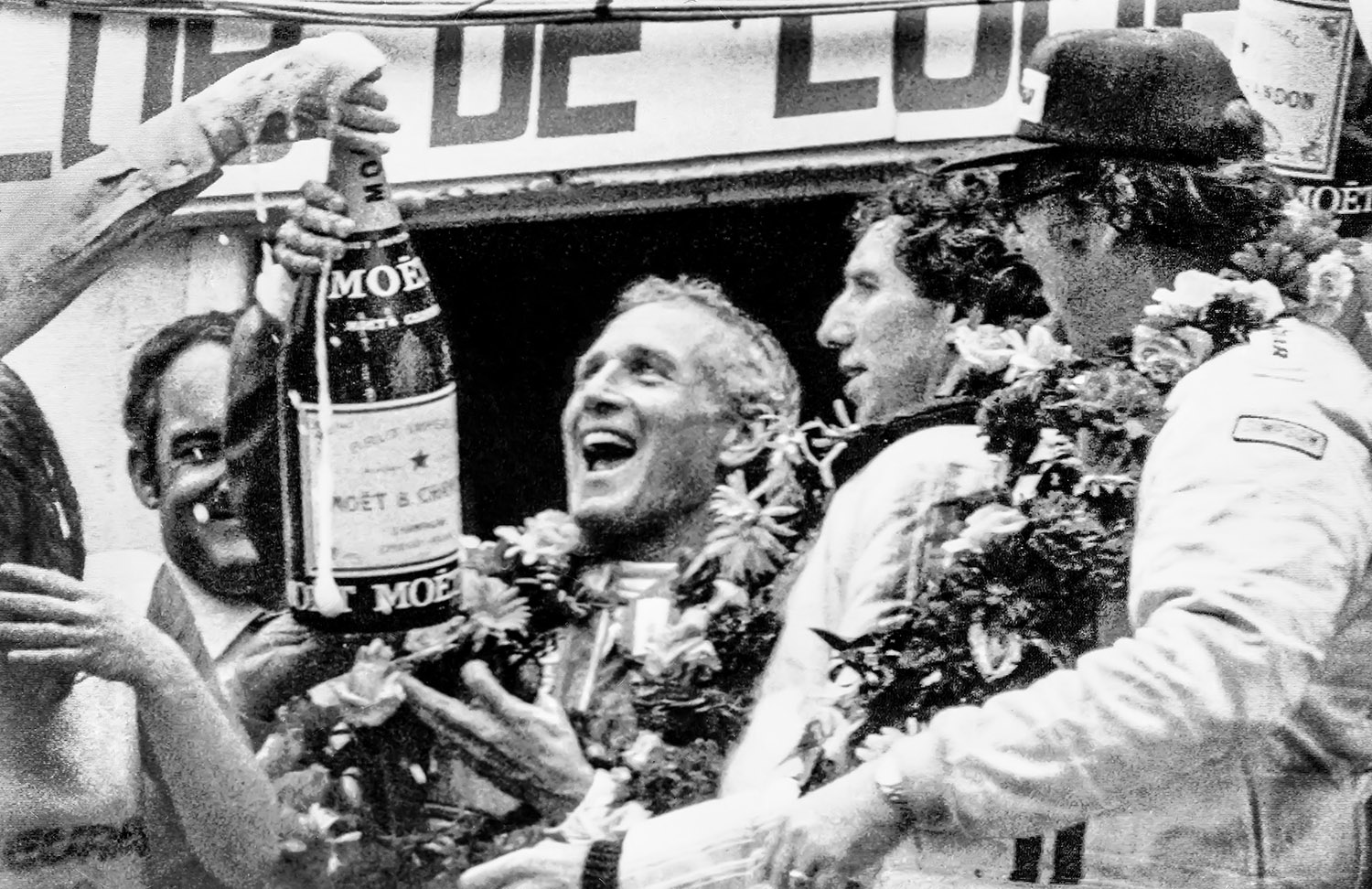
Paul Newman, jokes with a bottle of champagne on June 11, 1979 after he finished second. From left on the podium: Paul Newman, Rolf Stommelen and Dick Barbour of San Diego, team owner. “Other than at the wheel or lessons from Stommelen, whom he admired greatly, probably the only enjoyable moment at Le Mans for Newman.” –Tim Considine (AP Photo)
Q. Paul Newman had a rough time with the press. I imagine we all wanted to interview Paul about his racing career. But you pulled it off. Did you know him previously, and was it easy to get him to talk about his Le Mans experience?
A. I really only knew him only through racing. But my brother John knew him well. We talked at Long Beach, and he was pretty straightforward, typically modest – his quote, “I didn’t exactly cover myself with glory,” was a favorite, though an exaggeration. Interesting contrast between Newman’s discomfort and Patrick Dempsey’s ease dealing with the attention [Dempsey has competed at Le Mans four times.] But in Newman’s day, movie stars were much more private and distant from the public, and that was kind of understood. He was a very private person, and always kept his celebrity away from racing – no autographs. With Dempsey, he came into people’s homes via TV and the distance between celebrities and the public had virtually disappeared. Dempsey was particularly adept at dealing with that, I think, and in fact, consciously and cleverly used his celebrity to advance his racing. It is a different age.
Q. Celebrity racers in general – aside from James Dean and the above, were there others who were particularly good?
A. Well, Newman and McQueen were the best, and the best known. And James Dean. And there was a country and western singer, Marty Robbins, in NASCAR. And Jim Garner got into it. But the most interesting cases for me were David Nelson, of Ozzie and Harriet, who actually raced midgets actively on the dirt without many knowing, and Billy Gray, the great kid actor of Father Knows Best – who raced flat-track motorcycles! Racers have to be selfish, in a way, able to shut out everything and everyone and concentrate. Much like actors do in their work. So that ability allows performers to more easily do that. I mean, that’s not all there is to it, obviously, but it’s a leg-up on others, I think.
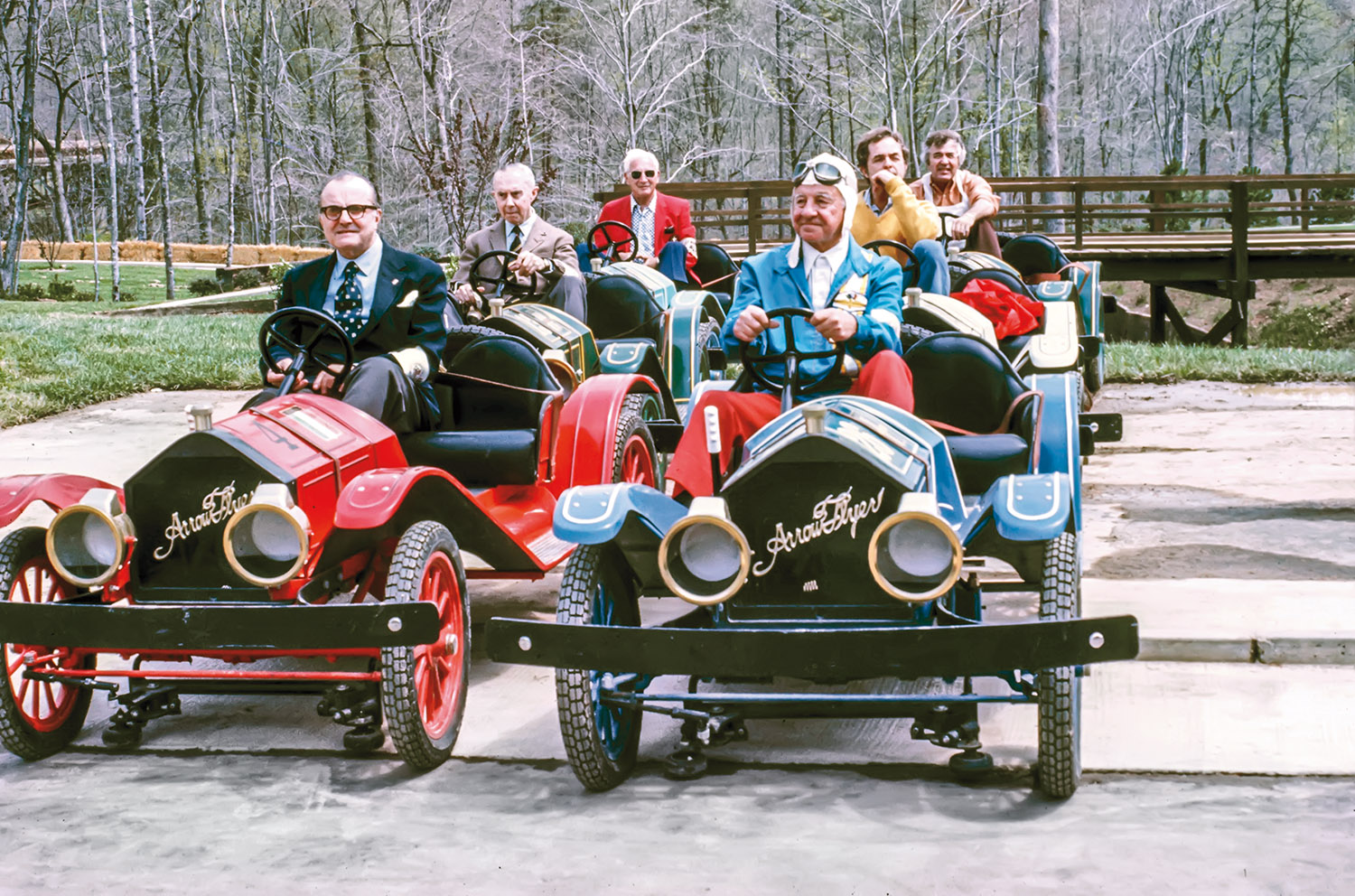
Six great American heroes pose for a vintage auto parade at Le Mans in 1975. Luigi Chinetti is next to Peter de Paolo, then René Dreyfus and Phil Hill, and in the last row Zora Arkus-Duntov and Carroll Shelby. “Notice Phil, bored as hell. He didn’t suffer fools or nonsense easily. Such a great man. Gave me hours over the years for Yanks. As did Shelby, and of course, Dan. Did you notice the name of our company – Toll Hall Sexton Books? Their middle names. –Tim Considine. (REVS Institute photo)
Get it while it’s hot
If you haven’t yet figured it out, we rate this work at the very top of any we have read, ever. There are only 1,000 copies, half of which have already been purchased. Do not hesitate to buy a copy. You will be pleased, we guarantee it.
Though American cars, engines and teams are all covered, Yanks is primarily about people and personal experiences at Le Mans. For Volumes I-III alone, Considine interviewed a great number of participants and witnesses, drivers with an asterisk.
Dennis Aase*
Randy Aase
Edwin Abate*
Tony Adamowicz*
Charlie Agapiou
Mario Andretti*
Hugh Bancroft*
Dick Barbour*
Doug Bergen
Bob Bondurant*
Peter Brock
Jim Busby*
Joe Buzzetta*
Allan Carter
Duane Carter*
Jay Chamberlain*
Luigi Chinetti Jr.*
Harley Cluxton*
Howard Coombs
Briggs Cunningham*
Mark Donohue*
Steve Earle*
John Fitch*
Elliot Forbes-Robinson*
Edsel Ford
A.J. Foyt*
Dick Frisk
Brad Frisselle*
Dick Fritz
Benoit Froger
Fred Gamble*
Bob Garretson*
John ‘Jack’ Gordon*
Jerry Grant*
Henri Greder *
Burt Greenwood*
John Greenwood*
Dick Guldstrand*
Dan Gurney*
Jim Hall*
Hurley Haywood*
Preston Henn*
Phil Hill*
David Hobbs*
John Horsman
John Hotchkis*
Ed Hugus*
Jim Jeffords*
Alan Johnson*
Bob Johnson*
Sherwood Johnston*
Kas Kastner
Bob Kennedy
Bruce Kessler*
Michael Keyser*
Rick Knoop*
Leon ‘Lee’ Lilley*
Pete Lovely*
Bob Lutz
Ed Matsuishi
Denise McCluggage
Doug McGriff*
Hershel McGriff
Phillip ‘Skeeter’ McKitterick*
Leo Mehl
John Morton*
Joel Nelson
Paul Newman*
Augie Pabst*
Scooter Patrick*
Roger Penske*
Roy Pike*
Sam Posey*
Brian Redman*
Phil Remington
Al Roberts
John Rulon-Miller*
Tony Settember*
Carroll Shelby*
Stan Smith
Judy Stropus
Dick Thompson*
Randolph Townsend*
Bob Tullius*
Phil Walters*
Tom Waugh*
Bill Whittington*
Don Whittington*
Jonathan Williams
John Woodard
Twice Around The Clock – The Yanks At Le Mans Vol. I-III
Author: Tim Considine
Publication Date: October, 2018
ISBN: 978-0-9993953-0-1
Page Size: 9 x 11 inches
Three volumes, hard cover in slipcase
Vol. I (1923 – 1959): 408 pages / 371 photographs
Vol. II (1960 – 1969): 360 pages / 327 photographs
Vol. III (1970 – 1979): 328 pages / 227 photographs
Note! If you want an autographed copy, request one from the CONTACT button, which goes straight to Considine.
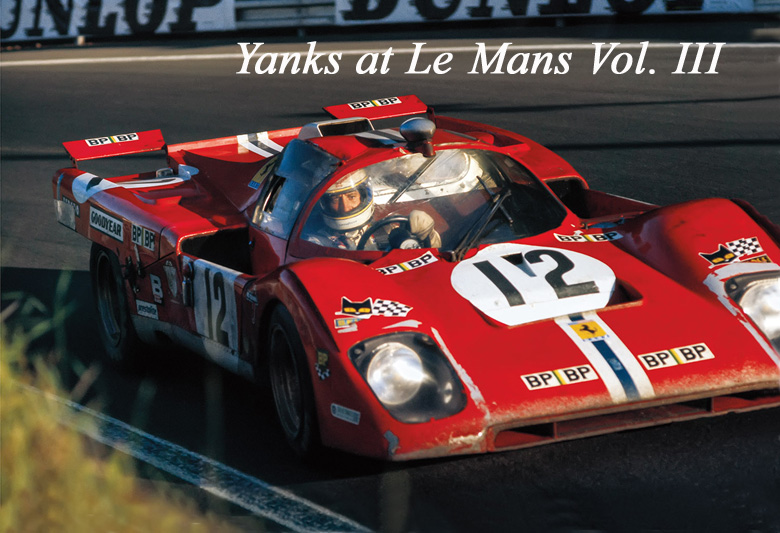
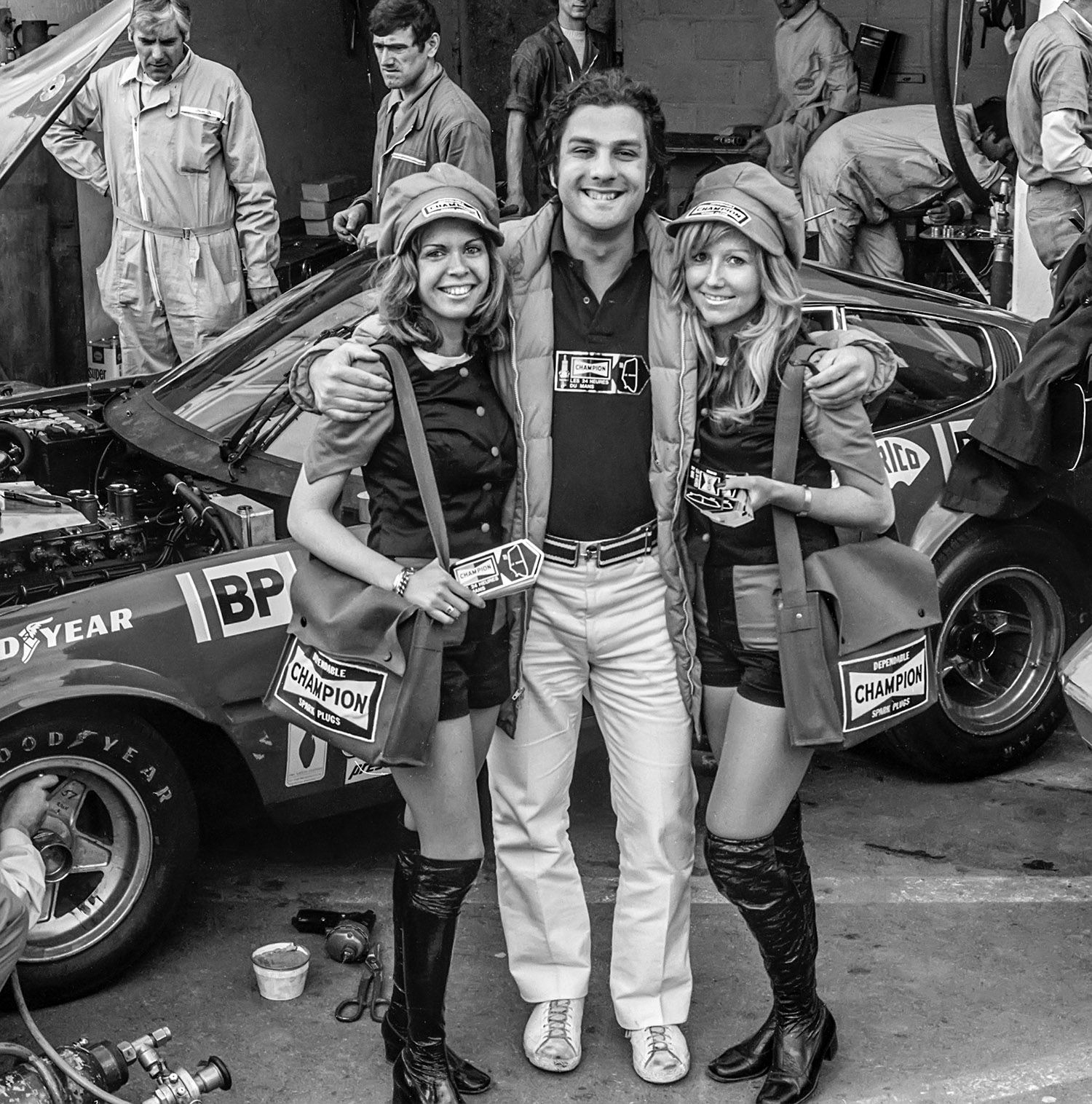
“Yanks” … Not much more to say that Peter has not said about this work.
This is an important document of fact and an exciting telling of the inside stories of the race that has called out to so many American drivers.
Fantastic work! Not only captures all of the details of the races – I mean all – but the words of the drivers and others, their attitudes, feelings, and personalities are the real gems. Bought it a month ago and allotted myself a year to go through it, and I’m almost through with book 3. I’ll go back over and over. Even though you know the outcomes, each race reads like a thriller you can’t wait to get to the end of.
Other movie personalities that raced….I went to an indoor ice circle track motorcycle race at the Cow Palace in the 70s. One of the racers was the character Bud who was in Ozzie and Harriet TV series as I recall. I remember the announcer made a big deal about it. All I remember is that he went down about 3 times before throwing in the towel. Knowing how studios frowned on actors taking risks, I suspect that many who raced did it under a fake name.